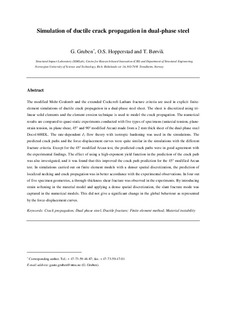| dc.contributor.author | Gruben, Gaute | |
| dc.contributor.author | Hopperstad, Odd Sture | |
| dc.contributor.author | Børvik, Tore | |
| dc.date.accessioned | 2017-10-10T07:40:32Z | |
| dc.date.available | 2017-10-10T07:40:32Z | |
| dc.date.created | 2013-04-18T11:11:39Z | |
| dc.date.issued | 2013 | |
| dc.identifier.citation | International Journal of Fracture. 2013, 180 (1), 1-22. | nb_NO |
| dc.identifier.issn | 0376-9429 | |
| dc.identifier.uri | http://hdl.handle.net/11250/2459320 | |
| dc.description.abstract | The modified Mohr–Coulomb and the extended Cockcroft–Latham fracture criteria are used in explicit finite-element (FE) simulations of ductile crack propagation in a dual-phase steel sheet. The sheet is discretized using tri-linear solid elements and the element erosion technique is used to model the crack propagation. The numerical results are compared to quasi-static experiments conducted with five types of specimens (uniaxial tension, plane-strain tension, in-plane shear, 45° and 90° modified Arcan) made from a 2 mm thick sheet of the dual-phase steel Docol 600DL. The rate-dependent J2 flow theory with isotropic hardening was used in the simulations. The predicted crack paths and the force–displacement curves were quite similar in the simulations with the different fracture criteria. Except for the 45° modified Arcan test, the predicted crack paths were in good agreement with the experimental findings. The effect of using a high-exponent yield function in the prediction of the crack path was also investigated, and it was found that this improved the crack path prediction for the 45° modified Arcan test. In simulations carried out on FE models with a denser spatial discretization, the prediction of localized necking and crack propagation was in better accordance with the experimental observations. In four out of five specimen geometries, a through-thickness shear fracture was observed in the experiments. By introducing strain softening in the material model and applying a dense spatial discretization, the slant fracture mode was captured in the numerical models. This did not give a significant change in the global behaviour as represented by the force–displacement curves. | nb_NO |
| dc.language.iso | eng | nb_NO |
| dc.publisher | Springer Verlag | nb_NO |
| dc.title | Simulation of ductile crack propagation in dual-phase steel | nb_NO |
| dc.type | Journal article | nb_NO |
| dc.type | Peer reviewed | nb_NO |
| dc.description.version | acceptedVersion | nb_NO |
| dc.source.pagenumber | 1-22 | nb_NO |
| dc.source.volume | 180 | nb_NO |
| dc.source.journal | International Journal of Fracture | nb_NO |
| dc.source.issue | 1 | nb_NO |
| dc.identifier.doi | 10.1007/s10704-012-9791-2 | |
| dc.identifier.cristin | 1024458 | |
| dc.relation.project | Norges forskningsråd: 174834 | nb_NO |
| dc.description.localcode | © Springer Science+Business Media Dordrecht 2012. The final publication is available at https://link.springer.com/content/pdf/10.1007%2Fs10704-012-9791-2.pdf This is the authors' accepted and refereed manuscript to the article. | nb_NO |
| cristin.unitcode | 194,64,45,0 | |
| cristin.unitname | Institutt for konstruksjonsteknikk | |
| cristin.ispublished | true | |
| cristin.fulltext | postprint | |
| cristin.qualitycode | 2 | |
